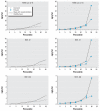Flame retardants in placenta and breast milk and cryptorchidism in newborn boys
- PMID: 17938745
- PMCID: PMC2022640
- DOI: 10.1289/ehp.9924
Flame retardants in placenta and breast milk and cryptorchidism in newborn boys
Abstract
Background: Polybrominated diphenyl ethers (PBDEs) are widely used in Western countries.
Objectives: Because the prevalence of cryptorchidism appears to be increasing, we investigated whether exposure to PBDEs was associated with testicular maldescent.
Methods: In a prospective Danish-Finnish study, 1997-2001, all boys were examined for cryptorchidism. We analyzed whole placentas (for 95 cryptorchid/185 healthy boys) and individual breast milk samples (62/68) for 14 PBDEs and infant serum samples for gonadotropins, sex-hormone binding globulin, testosterone, and inhibin B.
Results: In 86 placenta-milk pairs, placenta PBDE concentrations in fat were lower than in breast milk, and a larger number of congeners were nondetectable. There was no significant difference between boys with and without cryptorchidism for individual congeners, the sum of 5 most prevalent, or all 14 congeners. The concentration of PBDEs in breast milk was significantly higher in boys with cryptorchidism than in controls (sum of BDEs 47, 153, 99, 100, 28, 66, and 154: median, 4.16 vs. 3.16 ng/g fat; p < 0.007). There was a positive correlation between the sum of PBDEs and serum luteinizing hormone (p < 0.033). The sum of PBDEs in breast milk did not differ between Denmark and Finland (median, 3.52 vs. 3.44 ng/g fat), but significant differences in some individual congeners were found.
Conclusions: Two different proxies were used for prenatal PBDE exposure, and levels in breast milk, but not in placenta, showed an association with congenital cryptorchidism. Other environmental factors may contribute to cryptorchidism. Our observations are of concern because human exposure to PBDEs is high in some geographic areas.
Keywords: breast milk; cryptorchidism; exposure; human; infant; polybrominated diphenyl ethers.
Figures


Comment in
-
Cryptorchidism: effects of maternal diabetes or PBDEs.Environ Health Perspect. 2008 May;116(5):A195; author reply A195-6. doi: 10.1289/ehp.11096. Environ Health Perspect. 2008. PMID: 18470289 Free PMC article. No abstract available.
-
Polybrominated diphenyl ethers and cryptorchidism: confounding or cause and effect?Environ Health Perspect. 2008 May;116(5):A194; author reply A194-5. doi: 10.1289/ehp.11052. Environ Health Perspect. 2008. PMID: 18470292 Free PMC article. No abstract available.
Similar articles
-
Body burdens of polybrominated diphenyl ethers in childbearing-aged women at an intensive electronic-waste recycling site in China.Environ Sci Pollut Res Int. 2010 Aug;17(7):1300-13. doi: 10.1007/s11356-010-0310-6. Epub 2010 Mar 19. Environ Sci Pollut Res Int. 2010. PMID: 20300869
-
Geographical distribution and accumulation features of PBDEs in human breast milk from Indonesia.Environ Pollut. 2008 Jan;151(1):130-8. doi: 10.1016/j.envpol.2007.02.016. Epub 2007 May 7. Environ Pollut. 2008. PMID: 17482735
-
Distribution of polybrominated diphenyl ethers in breast milk, cord blood and placentas: a systematic review.Environ Sci Pollut Res Int. 2017 Sep;24(27):21548-21573. doi: 10.1007/s11356-017-9821-8. Epub 2017 Aug 22. Environ Sci Pollut Res Int. 2017. PMID: 28831660
-
Association of placenta organotin concentrations with congenital cryptorchidism and reproductive hormone levels in 280 newborn boys from Denmark and Finland.Hum Reprod. 2013 Jun;28(6):1647-60. doi: 10.1093/humrep/det040. Epub 2013 Mar 21. Hum Reprod. 2013. PMID: 23520400
-
The PBDEs: an emerging environmental challenge and another reason for breast-milk monitoring programs.Environ Health Perspect. 2000 May;108(5):387-92. doi: 10.1289/ehp.00108387. Environ Health Perspect. 2000. PMID: 10811563 Free PMC article. Review.
Cited by
-
Using mouse models of autism spectrum disorders to study the neurotoxicology of gene-environment interactions.Neurotoxicol Teratol. 2013 Mar-Apr;36:17-35. doi: 10.1016/j.ntt.2012.08.007. Epub 2012 Sep 7. Neurotoxicol Teratol. 2013. PMID: 23010509 Free PMC article. Review.
-
Polybrominated diphenyl ethers and cryptorchidism: confounding or cause and effect?Environ Health Perspect. 2008 May;116(5):A194; author reply A194-5. doi: 10.1289/ehp.11052. Environ Health Perspect. 2008. PMID: 18470292 Free PMC article. No abstract available.
-
Brominated Flame Retardants in Children's Room: Concentration, Composition, and Health Risk Assessment.Int J Environ Res Public Health. 2021 Jun 14;18(12):6421. doi: 10.3390/ijerph18126421. Int J Environ Res Public Health. 2021. PMID: 34198502 Free PMC article.
-
Hydroxylated metabolites of the polybrominated diphenyl ether mixture DE-71 are weak estrogen receptor-alpha ligands.Environ Health Perspect. 2008 Oct;116(10):1315-21. doi: 10.1289/ehp.11343. Epub 2008 May 27. Environ Health Perspect. 2008. PMID: 18941571 Free PMC article.
-
Associations of birth outcomes with maternal polybrominated diphenyl ethers and thyroid hormones during pregnancy.Environ Int. 2015 Dec;85:244-53. doi: 10.1016/j.envint.2015.09.015. Epub 2015 Sep 29. Environ Int. 2015. PMID: 26431883 Free PMC article.
References
-
- Agency for Toxic Substances and Disease Registry. Toxicological Profile for Polybrominated Biphenyls and Polybrominated Diphenyl Ethers (PBBs and PBDEs) 2004. [accessed 30 March 2007]. Available: www.atsdr.cdc.gov/toxprofiles/tp68.html.
-
- Alaee M, Arias P, Sjödin A, Bergman A. An overview of commercially used brominated flame-retardants, their application, their use in different countries/regions and possible modes of release. Environ Int. 2006;29:683–689. - PubMed
-
- Andersson A-M, Toppari J, Haavisto A-M, Petersen JH, Simell T, Simell O, et al. Longitudinal reproductive hormone profiles in infants: peak of inhibin B levels in infant boys exceeds levels in adult men. J Clin Endocrinol Metab. 1998;83:675–681. - PubMed
-
- [Anonymous] Polybrominated diphenyl ether levels among United States residents: daily intake and risk of harm to the developing brain and reproductive organs. Integr Environ Assess Manag. 2005;1:343–354. - PubMed
Publication types
MeSH terms
Substances
LinkOut - more resources
Full Text Sources
Other Literature Sources

